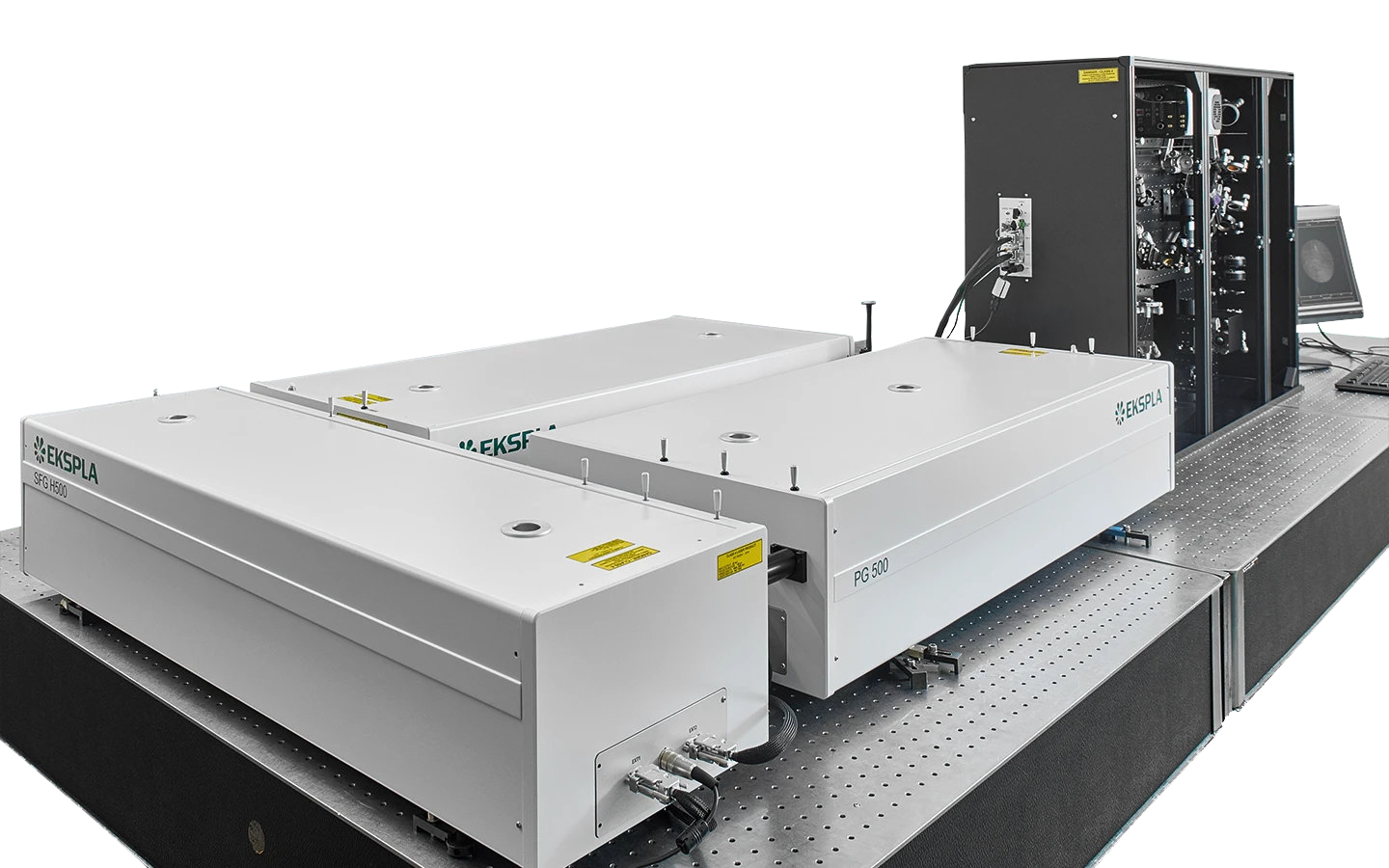Scanning SFG Spectrometer
Pikosekunden Scanning Sum-Frequency- Generation-Vibration Spektrometer
Das spektral hochauflösende Spektromer-System regt die Vibrationsbänder scannend an und misst das SFG Spektrum mit einem Photomultiplier mit zeitlichem Gate.

Vorteile
- Einsatzfähig für alle Genzflächen
- Messung von Subnanoschichten bis in den Submonolayer-Bereich
- Selektive Messung einzelner Vibrationsbänder
- Selektive Messung der Ausrichtung von Molekülen der Grenzfläche
- Non-Destruktiv
- Hohes räumliches und spektrales Auflösungsvermögen
Anwendungen
- Grenzflächenanalyse von Festkörpern, Flüssigkeiten, Polymeren, Biomembranen und weiteren Materialien
- Analyse der Oberflächenstruktur, chemischer Zusammensetzung und molekularer Ausrichtung
- Erforschung von Oberflächenreaktionen unter realer Atmosphäre, z. B. Katalyse oder Oberflächendynamik
- Geeignet für Studien im Bereich epitaxialem Wachstum, Elektrochemie, Material und Umgebungsproblematiken
Wissenschafliche Veröffentlichungen
Hydrogen bonding interactions of H₂O and SiOH on a boroaluminosilicate glass corroded in aqueous solution
D. Ngo, H. Liu, Z. Chen, H. Kaya, T. J. Zimudzi, S. Gin et al., npj Materials Degradation 4 (1), 1 (2020). DOI: 10.1038/s41529-019-0105-2.
Hydrogen bonding interactions play an important role in many chemical and physical processes occurring in bulk liquids and at interfaces. In this study, hydrous species (H2O and Si-OH) on nano-porous alteration layers (gels) formed on a boroaluminosilicate glass called International Simple Glass corroded in aqueous solutions at pH 7 and pH 9, and initially saturated with soluble silicon-containing species were analyzed using linear and non-linear vibrational spectroscopy in combination with molecular dynamics simulations. The simulation results revealed various possible types of hydrogen bonds among these hydrous species in nanoconfinement environments with their populations depending on pore-size distribution. The nano-porous gels formed on corroded glass surfaces enhance hydrogen bond strength between hydrous species as revealed by attenuated total reflectance infrared spectroscopy. Sum frequency generation spectroscopy showed some significant differences in hydrogen bonding interactions on alteration layers formed at pH 7 and pH 9. The glass dissolution under the leaching conditions used in this study has been known to be ten times faster at pH 7 in comparison to that at pH 9 due to unknown reasons. The simulation and experimental results obtained in this study indicate that the water mobility in the gel formed at pH 9 could be slower than that in the gel formed at pH 7, and as a result, the leaching rate at pH 9 is slower than that at pH 7.
Structure Determination of Hen Egg-White Lysozyme Aggregates Adsorbed to Lipid/Water and Air/Water Interfaces
S. Strazdaite, E. Navakauskas, J. Kirschner, T. Sneideris, and G. Niaura, Langmuir 36 (17), 4766-4775 (2020). DOI: 10.1021/acs.langmuir.9b03826.
We use vibrational sum-frequency generation (VSFG) spectroscopy to study the structure of hen egg-white lysozyme (HEWL) aggregates adsorbed to DOPG/D2O and air/D2O interfaces. We find that aggregates with a parallel and antiparallel β-sheet structure together with smaller unordered aggregates and a denaturated protein are adsorbed to both interfaces. We demonstrate that to retrieve this information, fitting of the VSFG spectra is essential. The number of bands contributing to the VSFG spectrum might be misinterpreted, due to interference between peaks with opposite orientation and a nonresonant background. Our study identified hydrophobicity as the main driving force for adsorption to the air/D2O interface. Adsorption to the DOPG/D2O interface is also influenced by hydrophobic interaction; however, electrostatic interaction between the charged protein’s groups and the lipid’s headgroups has the most significant effect on the adsorption. We find that the intensity of the VSFG spectrum at the DOPG/D2O interface is strongly enhanced by varying the pH of the solution. We show that this change is not due to a change of lysozyme’s and its aggregates’ charge but due to dipole reorientation at the DOPG/D2O interface. This finding suggests that extra care must be taken when interpreting the VSFG spectrum of proteins adsorbed at the lipid/water interface.
Aggregation states of poly (4-methylpentene-1) at a solid interface
K. Yamamoto, D. Kawaguchi, K. Sasahara, M. Inutsuka, S. Yamamoto, K. Uchida et al., Polymer Journal 51 (2), 247-255 (2019). DOI: 10.1038/s41428-018-0134-7.
A thin film of poly (4-methylpentene-1) (P4MP1) was prepared on a quartz substrate, which was a model system of an interface in filler-reinforced semicrystalline polymer composites. Grazing-incidence wide-angle X-ray diffraction measurements revealed that P4MP1 in the thin film after isothermal crystallization formed a Form I crystal polymorph composed of a tetragonal unit cell with a 72 helix, in which the chain axis was oriented along the direction parallel to the quartz interface. Combining sum-frequency generation vibrational spectroscopy with molecular dynamics simulation enabled us to gain access to the local conformation of P4MP1 chains at the quartz interface and the changes that occurred with isothermal crystallization. Finally, the way in which the initial chain orientation at the substrate interface impacted the crystalline structure in the thin film was discussed.
